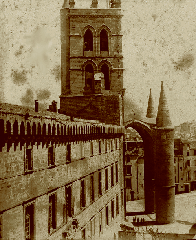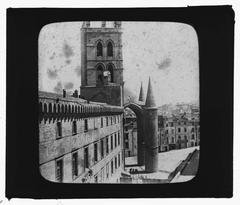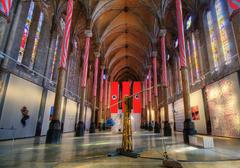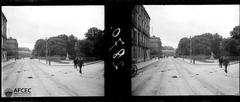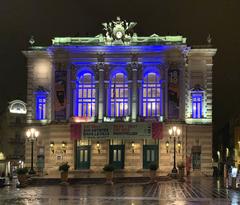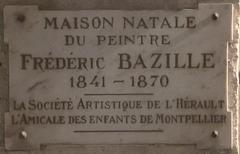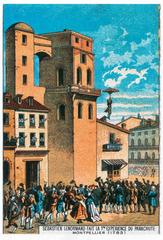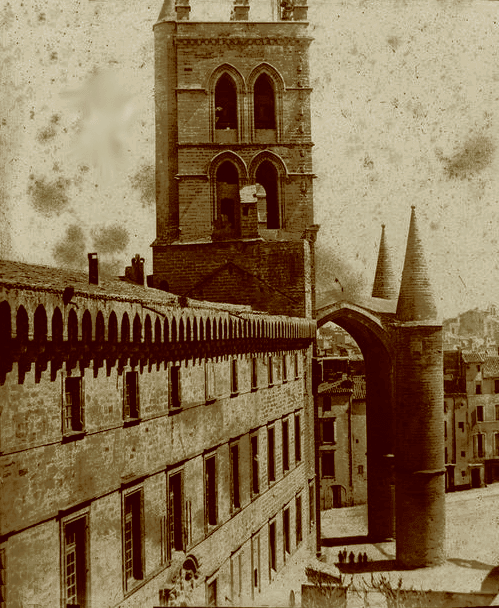
Montpellier Cathedral: Visiting Hours, Tickets, and Complete Guide to Montpellier’s Historical Landmark
Date: 14/06/2025
Introduction: A Timeless Symbol of Montpellier
The Cathédrale Saint-Pierre de Montpellier, nestled in the city’s medieval Écusson district, stands as a striking testament to centuries of faith, history, and architectural ingenuity. Originally built in the mid-14th century as the chapel of a Benedictine monastery, it has evolved into the city’s spiritual and cultural heart. Its imposing Southern Gothic style—marked by massive cylindrical porch pillars—evokes both religious devotion and the region’s turbulent past. The cathedral’s elevation to episcopal status in 1536 signaled Montpellier’s growing importance, and today, its robust presence continues to shape the local landscape, both physically and culturally (cathedrale-montpellier.fr; francerent.com; PlanetWare).
This guide offers a detailed exploration of the cathedral’s history, architecture, and significance, alongside up-to-date visitor information, accessibility guidance, and tips for experiencing Montpellier’s broader heritage.
Table of Contents
- Introduction
- Historical Overview
- Religious and Cultural Significance
- Visiting Montpellier Cathedral
- Architectural Highlights
- Frequently Asked Questions (FAQ)
- Conclusion and Visitor Resources
- Sources
Historical Overview
Origins and Foundation
Founded in 1364 under Pope Urban V, who had deep ties to Montpellier, the cathedral began as the chapel for the Benedictine Monastery-Collège Saint-Benoît Saint-Germain. By 1367, it was consecrated and rapidly became a center of spiritual life and learning, reflecting Montpellier’s emergence as a major hub in Languedoc (cathedrale-montpellier.fr; the-southoffrance.com; travelsetu.com).
From Monastic Chapel to Cathedral
In 1536, with royal authorization, the bishopric seat moved from Maguelone to Montpellier, elevating the chapel to cathedral status. This transition solidified the building’s central role in the religious, political, and economic life of the city (wikipedia.org; cathedrale-montpellier.fr).
Architectural Evolution
Medieval and Gothic Foundations
The cathedral’s Southern Gothic character is evident in its single nave, flanking chapels, and the massive porch (baldaquin) supported by two cylindrical pillars—each over 4.5 meters in diameter. Four towers originally crowned the structure, though only three remain following the religious conflicts of the 16th century (cathedrale-saint-pierre-de-montpellier.culture.gouv.fr; montpellier-france.com).
Wars of Religion and Restoration
Montpellier’s strategic importance during the French Wars of Religion led to substantial damage in 1567, including the destruction of one of the original towers. Restoration efforts in the 17th and 18th centuries preserved much of the Gothic character while introducing classical elements (the-southoffrance.com; wikipedia.org).
19th-Century Renovation
Major restoration between 1855 and 1875, led by Henri-Antoine Revoil, rebuilt the bell tower, added radiating chapels, and introduced Burgundian-style glazed tiles to the choir roof. The cathedral was reconsecrated in 1875 and classified as a Monument Historique in 1906 (cathedrale-montpellier.fr).
Religious and Cultural Significance
Montpellier Cathedral is a beacon of Catholic resilience in a city shaped by centuries of religious change. Its defensive architecture reflects the need for protection during times of conflict while also serving as a symbol of spiritual authority. As the seat of the Archbishop of Montpellier, it remains a living center of worship, hosting Masses, major diocesan events, and cultural happenings (driftwoodjournals.com; PlanetWare).
Situated next to Europe’s oldest Faculty of Medicine, the cathedral also highlights Montpellier’s tradition as a meeting point for faith, science, and the arts (France Today).
Visiting Montpellier Cathedral
Opening Hours
- Monday to Saturday: 10:00 – 12:00 and 14:00 – 18:00
- Sunday: 14:00 – 18:00 (morning reserved for worship)
Hours may vary on religious holidays, during special events, or for conservation. Always check the Montpellier Tourism Office or the official cathedral website before your visit.
Admission and Tickets
- Entry: Free for individual visitors
- Guided Tours: May incur a fee; often available via the Montpellier Méditerranée Tourist Office, sometimes included with the Montpellier City Card
Guided Tours
- Languages: French, with private tours in other languages available
- Content: History, architecture, and hidden features
- Booking: Recommended in advance, especially during busy periods
Accessibility and Facilities
- Wheelchair Access: Partial—main entrance has steps, no lifts or interior ramps. Some areas may be inaccessible; contact the Tourist Office for support
- Restrooms: Not available on-site; nearby cafés and the Tourist Office provide facilities
- Gift Shop: None at the cathedral; the Tourist Office offers souvenirs
- Photography: Non-flash allowed for personal use; tripods and commercial photography require permission
Travel Tips and Nearby Attractions
- Best Times: Visit early or late afternoon to avoid crowds (peak: 3–4 PM; source: TripHobo)
- Dress Code: Modest attire recommended
- Nearby Sights: Jardin des Plantes, Faculty of Medicine, Musée Atger, Musée Fabre, Place de la Comédie (TripHobo)
- Public Transport: Nearest tram stop—Louis Blanc (Tram 1 & 4)
- Parking: No dedicated parking; use city car parks or public transport
Special Events
The cathedral hosts concerts, religious festivals, and cultural gatherings. See the Montpellier events calendar for details.
Architectural Highlights
- Southern Gothic Style: Single nave, fortress-like façade
- Porch with Twin Cylindrical Pillars: Over 4.5 meters in diameter, unique in France (travel2next.com)
- Vaulted Ceilings: 26 meters high, creating a sense of vertical grandeur (francerent.com)
- Stained Glass: Vibrant windows, including original and restored pieces (evendo.com)
- Grand Organ: 18th-century instrument, ornate and musically significant (francerent.com)
- Artworks: Paintings by Sébastien Bourdon and others
Frequently Asked Questions (FAQ)
Q: What are the cathedral’s opening hours?
A: Monday–Saturday 10:00–12:00 & 14:00–18:00; Sunday 14:00–18:00. Check for variations during holidays.
Q: Is there an admission fee?
A: Entry is free. Guided tours may have a fee.
Q: Are guided tours available?
A: Yes, via the Tourist Office and sometimes included with the City Card.
Q: Is the cathedral wheelchair accessible?
A: Partial accessibility; contact the Tourist Office for details.
Q: Can I take photos?
A: Yes, non-flash photography for personal use is allowed.
Q: Are there restrooms?
A: No, but nearby cafés and the Tourist Office provide facilities.
Q: What are the best nearby attractions?
A: Jardin des Plantes, Musée Fabre, Faculty of Medicine, and Place de la Comédie.
Conclusion and Visitor Resources
Montpellier Cathedral is not only a masterpiece of Southern French Gothic architecture but also a living symbol of the city’s enduring heritage. Its rich history, cultural significance, and central location make it an essential stop for any visitor. Plan your visit by checking updated hours and events, consider joining a guided tour, and explore the surrounding medieval heart of Montpellier for a comprehensive experience.
For more information, updated schedules, and to book guided tours, consult the Montpellier Cathedral official website and the Montpellier Tourism Office. Enhance your trip with the “Audiala” app for audio-guided experiences and follow local updates via social media channels.
Sources
- Montpellier Cathedral: History, Visiting Hours, Tickets & Must-See Attractions, Cathedrale Montpellier
- Montpellier Cathedral: Visiting Hours, Tickets, and Architectural Highlights, France Rent
- Top-Rated Attractions & Things to Do in Montpellier, PlanetWare
- Discovering Magnificent Montpellier, Little Wandering Wren
- Montpellier Cathedral, Wikipedia
- Best Things to Do in Montpellier, Driftwood Journals
- Travelsetu Guide to Montpellier Cathedral
- The South of France: Visiting Cathédrale Saint-Pierre de Montpellier
- TripHobo: Cathédrale Saint-Pierre or Montpellier Cathedral
- France Today: Montpellier Ambition and Architecture
- Montpellier Tourist Office
- Evendo: Montpellier Cathedral Attraction
- Travel2Next: Things to Do in Montpellier
- Tourist Platform: 7 Historical Buildings to See in Montpellier
- France Voyage: Tourism in Montpellier
For enhanced planning, download the “Audiala” app and follow us on social media for updates, travel inspiration, and exclusive audio guides.
